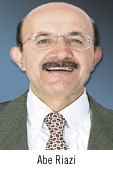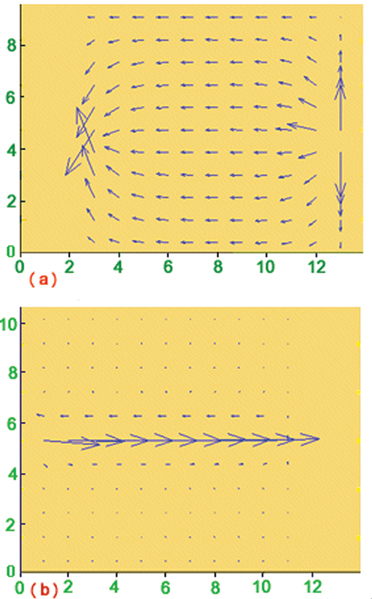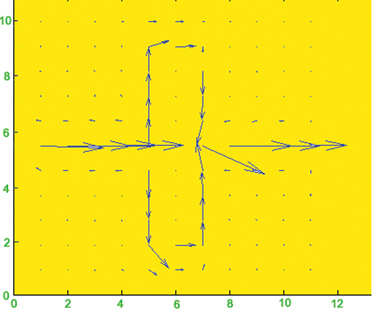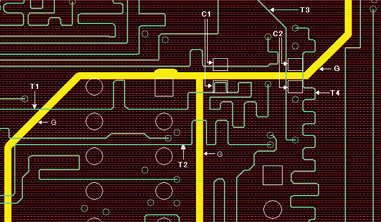
A high-speed signal crossing splits of a reference plane can experience undesirable electrical impact.
Routing
high-speed signals over slots of the nearby reference plane can cause
undesirable effects such as impedance discontinuities (destructive
reflection), EMI noise1 and crosstalk. The reference plane may be a ground or a power layer.
One
effective approach for gaining insight regarding the effects of plane
split boundaries is to consider the nature of current flow. When a
high-speed current travels along a PCB trace, an equal and opposite
return current2 flows in the reference plane underneath that signal track. This current returns in a manner to diminish the total impedance3.
At
low frequencies this translates to minimizing resistance by spreading
over every possible path. At high frequencies the return current crowds
under the signal (on reference plane) to minimize inductance. An
interesting way to visualize the current pattern on a reference plane
is to define/model the geometry consisting of trace(s) and planes using
FastHenry, a free 3D field solver. Then generate a set of current
distribution files and plot them by applying Matlab commands4.
Although this approach has certain limitations it can provide useful
understanding regarding the behavior of the return current. Hence, this
technique was applied to simulate a trace with a solid reference plane
and a trace-crossing plane split. For each case the trace length, width
and thickness were set at 4 inches, 7 mils and 0.72 mils, respectively.
The trace to plane height was 5 mils and the width of plane slot
equaled 10 mils. The results for low frequency (f = 1.0 Hz) and high
frequency (f = 100 MHz) excitations are presented by Figure 1 and Figure 2.
The results of Figure 1 verify that for low frequencies the return current (traveling from source to sink points) spreads4 across the plane, whereas at high frequencies the current is focused beneath the signal trace.
|

FIGURE 1. Return current distribution on a solid reference plane at (a) low frequency and (b) high frequency.
|
|

FIGURE 2. Return current distribution for a high frequency signal crossing a split plane.
|
Figure 2 demonstrates the high frequency current distribution for a
split in the reference plane. FastHenry, in conjunction with Matlab,
were again applied to model the geometry, compute the current
distribution and plot the outcome. The outcome illustrates that the
slot interrupts the path of the return current forcing it to find a way
around the discontinuity.
One unusual feature of this visualization method is that sometimes current vectors4
point into empty space (plane gap). This happens because current
vectors do not precisely exhibit the current flow at a given point.
Slot of any width can cause a current diversion, which in turn increases the loop area and inductance5
of the signal path. This leads to added crosstalk, and EMI and
rise-time degradation. It is desirable to avoid slots in planes for
high-speed PCBs, but they can occur in certain situations.
Sometimes
ground layer splits happen because a board designer runs out of space
on a regular routing layer and places tracks on the ground plane5 by cutting a slot in the plane layer for routing traces. Ground slots can also occur due to improper5
connector layout. A power plane with splits results when multiple
powers are incorporated on the same plane layer. Power islands6 are among the most evident split-plane circumstances. The island’s boundary, or moat, defines a total break6
in the copper plane resulting in an isolated area. This approach is
often applied to create unique power regions that connect either to the
same voltage via a PI filter (composed of shunt capacitors and
ferrite/inductor) or to a voltage different from the rest of the plane.
If
a high-speed net is routed perpendicularly over moats, the signal trace
will experience added inductance, degraded rise-time, crosstalk and
EMI. Hence, an excellent rule is to avoid the routing of high-speed
nets over plane splits; however, the complexity of modern high-speed
PCBs may impose violations of this guideline.
Figure 3 displays a section of a multilayer board
produced using the Cadence Allegro PCB Design Software. The PCB was
examined utilizing Allegro Free Physical Viewer program by turning on
the desired signal layer and its reference power plane with other
layers turned off. The plane layer has a gap G due to boundaries of
multiple power islands. Here the gap width is 20 mils. There are
several traces (T1, T2, T3 and T4) of the signal layer routed over
splits of reference plane. C1 and C2 outline two stitching capacitors
(small valued caps with values ≤ 1 uF) to bridge the plane splits. The
adverse effects of plane slots on high-speed signals crossing them can
be minimized by implementing another plane tightly coupled7
via bypass and interplane capacitance. Such capacitance furnishes an AC
path for the signal’s return current and supports the switching edges.
The slots should not occur at the same location in both or all planes.
|

FIGURE 3. PCB signal traces routed over voids of the nearest reference power plane.
|
Stitching capacitors8, when properly placed, can reduce
current loop area, lower impedance discontinuity, and minimize adverse
effects on signal quality and EMI due to the crossing of splits. The
ends of stitching capacitors need to be connected to each plane
detached by the split.
The implementation method and location of capacitors play an important role in determining their effectiveness. In one study9,
applying a 600 MHz clock with 300ps rise/fall times, a 0.1uF stitching
capacitor was placed at one side of a signal bus (crossing plane
splits) at distances of 1, 0.5 and 0.1 inches and directly adjacent to
the edge-line. The signal waveform and overall radiation for these
configurations were ascertained via simulation. It revealed that
capacitors should be placed near (within 100 mils) the edge line. The
capacitor became ineffective9 when located more than half an inch away. PCD&M
Dr. Abe (Abbas) Riazi is a senior staff electronic design scientist with ServerWorks (a Broadcom Company) in Santa Clara, CA. He can be reached at This email address is being protected from spambots. You need JavaScript enabled to view it..
ACKNOWLEDGEMENTS
Special
thanks to Peter Arnold, Richard Kuo, Clement Yuen and Manvender Raghav
for reviewing this article and furnishing valuable feedback.
REFERENCES
1. Doug Brooks, “Slots in Planes,” Printed Circuit Design, March 1999, PP. 36-37.
2. Howard Johnson, “Visible Return Current,” online newsletter, Vol. 8, Issue 08, 2005.
3. Brain Young, “Digital Signal Integrity Modeling and Simulation with
Interconnects and Packages,” Prentice Hall, 2000, P. 413.
4. M. Kamon, C. Smithhisler, J. White, “FastHenry User’s Guide,” Sept. 26, 1996, PP. 32-38.
5. Howard Johnson and Martin Graham, “ High-Speed Digital Design; A
Handbook of Black Magic,” Prentice Hall 1993, PP. 194-197.
6. Stephen C. Thierauf, “High-Speed Circuit Board Signal Integrity,” Artech House, Inc., 2004, PP. 95-98.
7. Lee Ritchey, “Examining Rules of Thumb,” Printed Circuit Design, Jan. 2000, PP. 36-38.
8. “High-Speed USB Platform Design Guidelines, Rev. 1.0” Intel, 2001, P. 8.
9. Juan Chen, Weimin Shi, Adam J. Norman, Ponniah Ilavarasan,
“Electrical Impact of High-Speed Bus Crossing Plane Split,” IEEE
International Symposium on Electromagnetic Compatibility, 2002, PP.
861-865.

















